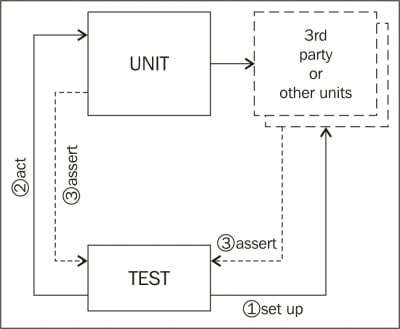As we saw earlier, a unit could be a feature if we are doing BDD, or it could be a component if we are doing traditional TDD. So, what does a unit test look like? From a very high level point of view, a unit test is like the following image:

You can see that the test is acting as the unit. The term "act" means that the test is performing a single operation on the unit through its public API.
Then, the test must check or assert the result of the operation. In this phase, we need to check whether the actual return value is as we expect, but we also need to check whether the side effects are the expected ones. A side effect is a message that the unit sends to other units or third-party systems in order to perform the action correctly.
Side effects look quite abstract, but in fact, they are very simple. For example, from the point of view of traditional TDD, a side effect can be a simple call from one class to another. From the point of view of BDD, a side effect can be a call to a third-party system, such as an SMS service, or a write to the database.
The result of an action will depend on the prior state of the system we are testing. It is normal that the expected result of the very same action varies according to the specific state the system is in. So, in order to write a test, we need to first set up or arrange the system in a well-known state. This way, our test will be repeatable.
To sum up, every test must have the following three phases:
Set up/Arrange: In this phase, we set up the state of the system in a well-known state. This implies choosing the correct input parameters, setting up the correct data in the database, or making the third-party systems return a well-known response.
Act: In this phase, we perform the operation we are testing. As a general rule, the act phase of each test should involve only one action.
Assert: In this phase, we check the return value of the operation and the side effects.
Whenever we see the term "unit testing", it means that we are making tests of the units of our system in an isolated way. By isolated, I mean that each test must check each unit in a way independent of the others. The idea is that if there is a problem with a unit, only the tests for that unit should be failing, not the other ones. In BDD, this means that a problem in a feature should only make the tests fail for that feature. In component unit testing, it means that a problem with a component (a class, for example) should only affect the tests for that class. That is why we prescribe that the act phase should involve only one action; this way, we do not mix behaviors.
However, in practice, this is not enough. Usually, features can be chained together to perform a user workflow, and components can depend on other components to implement a feature.
This is not the only problem, as we saw earlier; it is usually the case that a feature needs to talk with other systems. This implies that the set up phase must manipulate the state of these third-party systems. It is often unfeasible to do so, because these systems are not under our control. Furthermore, it can happen that these systems are not really stable or are shared by other systems apart from us.
In order to solve both the isolation problem and the set up problem, we can use test doubles. Test doubles are objects that impersonate the real third-party systems or components, just for the purpose of testing. There are mainly the following type of test doubles:
Fakes: These are a simplified implementation of the system we are impersonating. They usually involve writing some simple logic. This logic should never be complex; if not, we will end up reimplementing such third-party systems.
Stubs: These are objects that return a predefined value whenever one of its methods is called with a specific set of parameters. You can think of them as a set of hardcoded responses.
Spies: These are objects that record their interactions with our unit. This way, we can ask them later what happened during our assertion phase.
Mocks: These are self-validating spies that can be programmed during the set up phase with the expected interaction. If some interaction happens that is not expected, they would fail during the assertion phase.
We can use spies in the assertion phase of the test and stubs in the set up phase, so it is common that a test double is both a spy and a stub.
In this book, we will mostly use the first three types, but not mocks, so don't worry much about them. We will see plenty of examples for them in the rest of the book.



